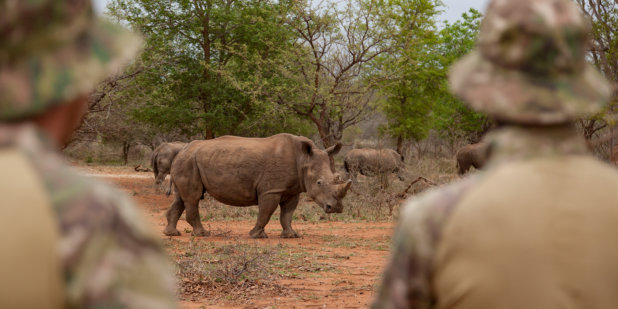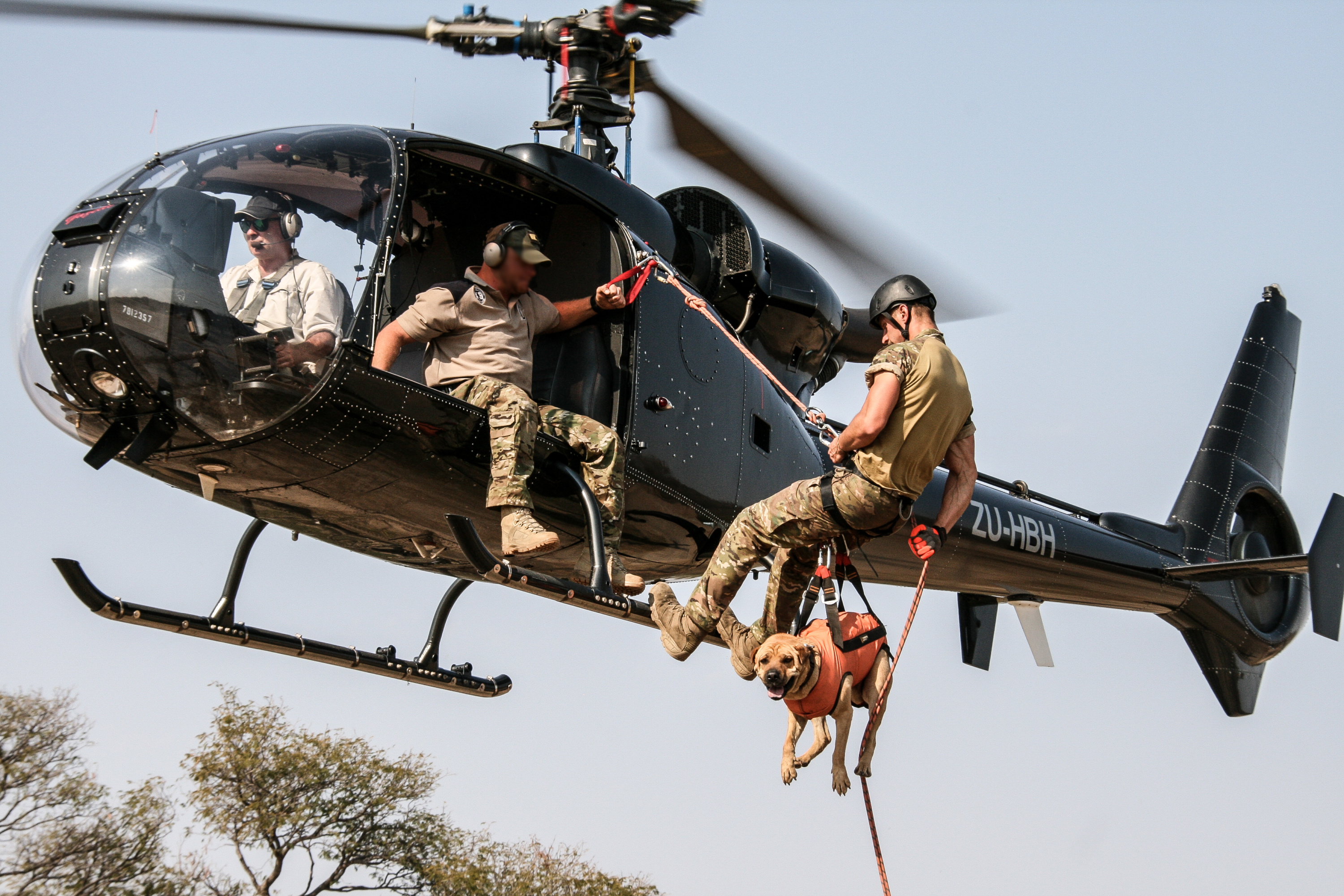- About
- Topics
- Picks
- Audio
- Story
- In-Depth
- Opinion
- News
- Donate
-
Signup for our newsletterOur Editors' Best Picks.Send
Read, Debate: Engage.


Tracking, finding and arresting poachers is a difficult task, anti-poaching rangers need extensive training, experience, equipment and determination. The topography of the land requires to use all possible means and vehicles: to be on foot, 4WDs, speed boats, helicopters and planes. Rhino Force is using all of them, but ultimately anti-poaching happens on the ground.
"The railway line is a big problem for us. It runs right through Balule, one of Greater Kruger's private game reserves. At night, the rails are ideal landmarks for orientation for the poachers. Sometimes the train drivers are actually hand in glove with the poachers and collude; they slow down the train, let the poachers jump off in the middle of the park or throw their prey onto the train and then drive on as if nothing had happened. Later, they justify these breaking maneuvers with the excuse that there was a big animal on the rail tracks."
Rhino Force car patrol through South African Balule Reserve with Anti-Poaching Ranger Chris
We accompany Chris, one of the rangers of Hemmersbach Rhino Force, on patrol through the Greater Kruger Park in northeastern South Africa. A tall, muscular guy in a military dress with a boyish friendly face; but Chris is also a clear-thinking analyst, aware of problems and dangers of the anti-poaching fight, besides all the recent successes on the ground to try and save the rhino.
Like most of the Hemmersbach Rhino Force Rangers, Chris has been through an intensive training boot camp. Around Kruger National Park they get prepared for the battle at the frontlines, which stretch along the protected areas of the remaining large wild animals in South Africa. Here they're getting used to military drill, close combat techniques, and semi-automatic weapons use. The training lasts three months; on average, forty percent of the recruits drop out earlier. Anyone who passes the final exam gets a guaranteed job as a ranger and a one-year employment contract.
An important part of the training are autopsies on dead animals. With the bullets found in the carcasses, they can prove in court that the deadly shots were fired from that specific weapon they caught together with the poacher. And, using the DNA samples that are also taken at autopsies, the investigators may be able to assign horns to poached animal carcasses.
We are approaching such a scene together with Pete Clemence, a Swaziland-born anti-poaching ranger. This time it's a poached elephant. The smell of decay of the carcass was already intense from the street a hundred meters away. Now, the once proud animal lies right in front of us. Half of the face is being cut off, the tusks are missing, a mixture of pus and blood drips from the bullet points, at other parts the vultures have already penetrated the thick skin.
"When a ranger finds such a carcass, the first thing he'll do is to check out if the horn or the tusks are still there or not", Clemence explains. "If they are still there, it is likely that the poachers have been disturbed and may still be nearby to wait and to take their prey with them later. The ranger then transmits the location's GPS data to headquarters, then makes a 360-degree search of the area and returns to the point where he entered the scene. There he waits for the tracking team – without touching anything of course; the tracking team then tries to scent the track and picks up the spur."
What a tracking team typically looks like, Pete Clemence reveals later at the Rhino Force camp in Zimbabwe. „A typical composition of a standard anti-poaching combat team is four rangers plus dogs: a tracker, two flankers and a controller", Clemence explains. „And basically they are all educated trackers, dog handlers, flankers, and controllers; so they can all interchange and change their positions within the team if for example one of them gets tired or erratic or feels insecure. And they can all self-adjust according to the terrain. So there is never too much burden on just one single person.“
In Southern Africa, Pete Clemence is a legend in the fight against poachers. Currently, he is training rangers on behalf of the Zimbabwean National Park Authority. "It takes a lot to be a good anti-poaching ranger," he says.
"Most important is what I call 'aggressive determination'. It's about the absolute will to protect the endangered animals and to hunt down poachers, no matter what. You just never ever let go!"
As an anti-poaching ranger, according to Clemence, one should not be afraid to lurk in an ambush in pursuit of poachers or to follow a trail even in the severe midday heat, when the sun burns down at them and the mosquitoes and flies almost drive them insane. And he must not shy away from taking up a chase at night, because poaching usually happens at night. "As a ranger, you have to own the night!", Clemence says.
"However, it is no longer just experience and determination that counts in the fight against poachers, but also - and increasingly - high-tech."
Koczwara has equipped Rhino Force with the latest generation of night vision goggles. "And that makes a huge difference," as Rhino Force ranger Chris confirms.
"So far, we've been widely visible with the headlamps of our 4WDs when we were on patrol; the poachers had enough time to respond before we arrived. With the night visions, we can now approach with headlights off, as our opponents can only notice us at the very last moment when we've already entered the crime scene."
For following a trail on foot, Koczwara has announced to equip them with strap-on infrared radiators in addition to the night visions. "With the night visions, the environment is generally brightened, and with the built-in infrared function and the infrared radiators, we can then distinguish living bodies from dead material. That should help us to avoid getting ambushed", Koczwara says. "And since the devices can be belt and strapped on, the Rangers have their hands free and can respond immediately to possibly dangerous situations."
Thus, the fight against poaching has become a war of financial firepower as well.
"Those who want to defeat the global syndicates must be willing and able to provide the necessary financial resources."
As for Rhino Force, the rangers are equipped with semi-automatic weapons, they are using quite sophisticated 4WDs and also small aircrafts and a speedboat. They are currently the best-equipped privately-funded anti-poaching unit in Africa, Koczwara says.
In the evening, at the camp in Zimbabwe, Pete Clemence mentions yet another important aspect. "As an anti-poaching ranger, it is important to be involved with local communities around the area. Because it is of immense importance to use informants as a source of intelligence. "However, you have to be careful", Clemence warns. "You have to be precautious when promising rewards to informants. You need quality criteria for all the intelligence you get. Because otherwise, it could end up rewarding an informant who induces community members to poach in order to collect the rewards."
Hence, corruption might turn out to be the most powerful opponent in the fight against the poaching syndicates. The fight for the survival of the last wild animals of our planet is being fought on many fronts. As for a modern anti-poaching ranger, that means he has to constantly improve himself to fight on the many front lines ahead. Quite a difficult task.
Photos and Videos: Frank Odenthal, Murat Suner
 We are on patrol, west of Kruger Park.
We are on patrol, west of Kruger Park.